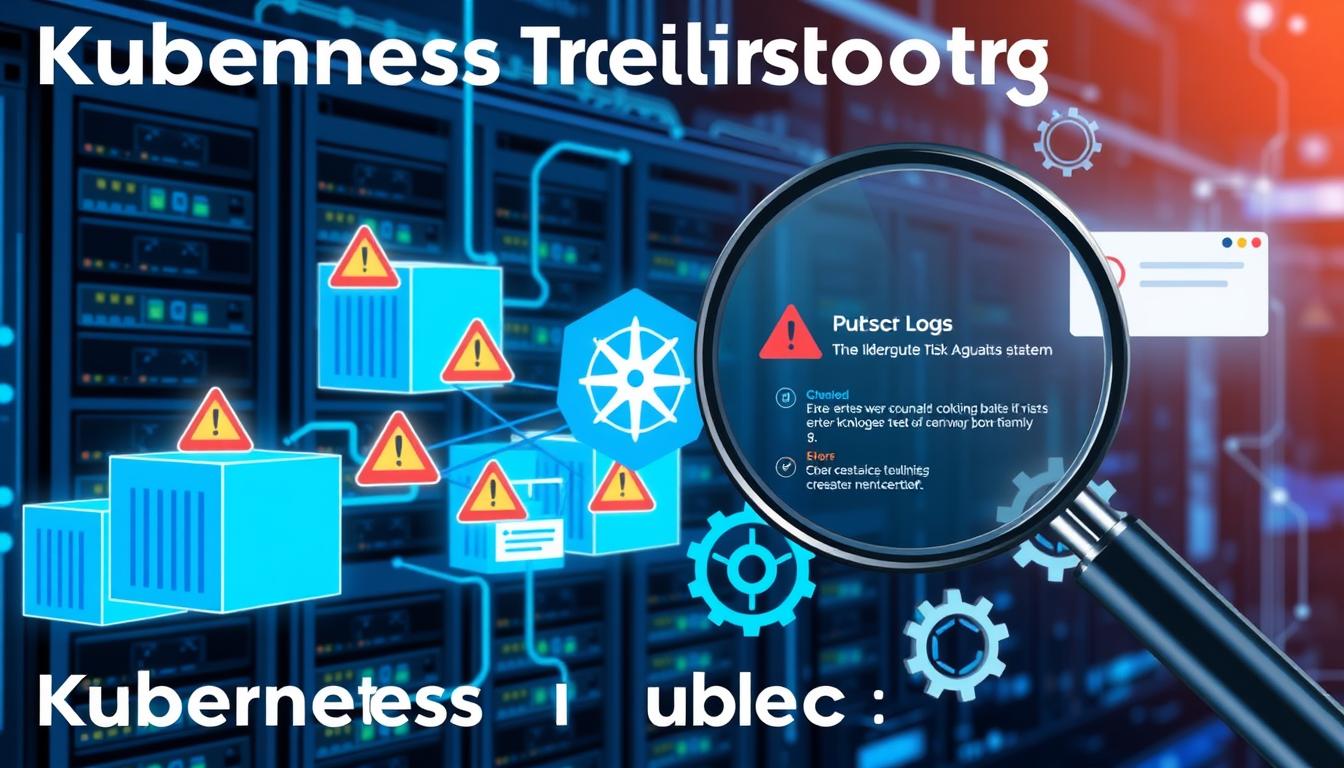Reflecting on my Kubernetes journey, I recall many times I had to fix issues. Kubernetes is a complex platform, even well-designed systems can face unexpected problems. Yet, this experience has given me valuable insights for managing Kubernetes and ensuring application success.
In this guide, we’ll dive into expert tips for troubleshooting Kubernetes. Whether you’re new or experienced, you’ll learn to spot and fix common problems. This will help keep your applications running smoothly and reliably.
Key Takeaways
- Gain a deep understanding of Kubernetes troubleshooting principles
- Identify and address common Kubernetes issues with confidence
- Leverage Kubernetes logging and monitoring to proactively detect and resolve problems
- Troubleshoot Kubernetes deployments, networking, and storage challenges
- Utilize powerful Kubernetes troubleshooting tools to streamline your workflow
Understanding Kubernetes Troubleshooting
Kubernetes has changed how we deploy and manage apps. It’s a powerful tool, but it can have problems that need fixing. Knowing how to troubleshoot Kubernetes is key for DevOps pros and Kubernetes admins.
Why Kubernetes Troubleshooting Matters
Fixing Kubernetes issues is vital for your apps’ reliability and performance. By solving common problems, your apps stay up and running well. This also saves you money and makes the most of your resources.
Common Kubernetes Issues
Here are some common Kubernetes problems:
- Pod Failures: Pods might not start or run right because of resources, mistakes in config, or app issues.
- Network Connectivity Problems: Issues with networking can block communication between Pods, Services, and outside systems.
- Storage Challenges: PVCs might not work right or could have data problems.
- Scaling and Load Balancing Difficulties: Autoscaling might not work as planned, leading to too many or too few resources.
- Security Vulnerabilities: Bad security settings can put your Kubernetes cluster at risk.
Knowing these common issues and how to fix them is crucial. It helps your Kubernetes apps run smoothly and efficiently, giving users the best experience.
Mastering Kubernetes Logging
Effective kubernetes logging is key for troubleshooting and keeping a Kubernetes cluster healthy. By setting up and managing Kubernetes logs right, you can spot and fix problems fast. This keeps your containerized apps running smoothly.
Kubernetes logging lets you see what’s happening in your cluster in detail. Logs show how your cluster is doing, what errors it has, and what’s happening. This helps you make smart choices and act quickly.
Configuring Kubernetes Logs
To log well in kubernetes, you need to set up your logging system. Use tools like Fluentd or Elasticsearch to collect and combine logs from containers, pods, and the API server.
- Know the log levels (like debug, info, warning, error) and pick the right one for your cluster.
- Make sure logs are in one place for easy searching, analyzing, and fixing problems.
- Use log rotation to keep log data from getting too big and causing storage issues.
Analyzing Kubernetes Logs
With your kubernetes logging set up, you can use tools and methods to dive into your logs. This includes:
- Use tools like Kibana or Grafana to see and explore your Kubernetes logs.
- Apply filters and search queries to find log entries about specific issues or events fast.
- Link logs from different parts (like pods, nodes, services) to find the main problem.
By getting good at kubernetes logging, you’ll have the insights to find and fix problems in your Kubernetes setup. This ensures your containerized apps are reliable and perform well.
Kubernetes Monitoring Essentials
Kubernetes has changed how we manage applications. It’s key to watch your Kubernetes environment closely. We’ll look at the main tools and metrics for keeping your Kubernetes running well.
Monitoring Tools for Kubernetes
Kubernetes has many tools for monitoring. Some top ones are:
- Prometheus: A top choice for kubernetes monitoring. It collects and stores kubernetes metrics for analysis.
- Grafana: Works well with Prometheus. It lets you create dashboards for deeper insights into Kubernetes.
- Kubernetes Dashboard: The official UI for monitoring and managing your cluster. It shows kubernetes metrics and resources.
- Datadog: A full monitoring and analytics platform. It gives detailed views of your cluster’s performance and health.
Metrics to Watch for Kubernetes
It’s crucial to monitor key metrics for your Kubernetes cluster’s health. Important kubernetes metrics include:
- CPU and memory usage: Watch these to spot bottlenecks or resource issues.
- Pod and container health: Ensure they’re running smoothly.
- Network traffic: Check for any network problems.
- Kubernetes API server: Its performance is vital for your cluster.
- Persistent volume usage: Make sure your apps have enough storage.
Using these kubernetes monitoring tools and tracking the right kubernetes metrics helps you solve problems early. This keeps your Kubernetes environment running smoothly.
Debugging Kubernetes Deployments
Kubernetes deployments and pods are key to your containerized setup. Finding and fixing problems with them can be tough. But, with the right methods, you can solve issues fast. Let’s look at how to debug Kubernetes deployments and pods effectively.
Troubleshooting Kubernetes Pods
Pods are the smallest units in Kubernetes. Knowing how to fix them is essential. Start by checking the pod’s status, logs, and events for any problems. If a pod won’t start or keeps crashing, look into a few things:
- Resource requests and limits: Make sure the pod’s needs fit within the cluster’s resources.
- Image pull errors: Confirm the container image can be pulled from the registry.
- Liveness and readiness probes: Check if the pod’s health checks are set up right.
- Environment variables: Verify the pod’s environment variables are correct.
By tackling these common problems, you can often fix pod issues and get your deployments running smoothly again.
| Kubernetes Deployment Troubleshooting | Kubernetes Pod Troubleshooting |
|---|---|
|
|
Understanding common issues and how to fix them for both deployments and pods helps keep your containerized environment running well.
“Kubernetes deployments and pods are the foundation of your containerized infrastructure. Troubleshooting issues with these components is crucial for ensuring smooth operations.”
Kubernetes Networking Troubleshooting
Dealing with Kubernetes networking can seem tough. But, with the right steps, you can find and fix common problems. We’ll look at common issues and offer solutions to keep your cluster running well.
One big worry in Kubernetes networking troubleshooting is how pods talk to each other. It’s key for your apps to work right. Issues might include wrong network policies, DNS problems, or network gaps.
- First, check your network policies to make sure they let the right traffic through.
- Also, make sure your DNS service is working and pods can find hostnames.
- If you still have problems, look at your node-to-node networking and make sure it’s set up right.
Another big challenge is load balancing and finding services. It’s important for a smooth user experience. Problems might be with the load balancer, service endpoints, or service mesh.
To fix these issues, follow these steps:
- Make sure your load balancer is set up right and points to the correct service endpoints.
- Check your service definitions to see if the endpoints are right and reachable.
- If you’re using a service mesh, make sure it’s working well with your Kubernetes cluster.
By tackling these common Kubernetes networking troubleshooting problems, you can make sure your cluster runs great. This means your apps will be reliable and scalable for your users.
Kubernetes troubleshooting
Dealing with kubernetes troubleshooting is key to a stable Kubernetes setup. We’ll look at strategies and tools for fixing various issues in your cluster.
Understanding Kubernetes components is crucial. From the control plane to worker nodes, each part is vital. Knowing these components helps you find and fix problems.
Leveraging Kubernetes Logging
Logging is a strong tool for kubernetes troubleshooting. Analyzing logs gives insights into your cluster’s behavior. This helps you quickly find and fix issues.
Monitoring Kubernetes Metrics
Monitoring your Kubernetes cluster is essential. Tracking metrics like resource use and pod health helps spot problems early. Tools like Prometheus and Grafana offer a detailed view of your cluster’s health.
Debugging Kubernetes Deployments
Fixing Kubernetes deployments is a big part of kubernetes troubleshooting. It involves understanding pod lifecycles and diagnosing container issues. Ensuring deployments are set up right is also important.
By learning these kubernetes troubleshooting methods, you can manage your Kubernetes environment well. This keeps your applications and services running smoothly.

Kubernetes Storage Troubleshooting
Kubernetes is a top container orchestration platform. It offers strong storage solutions like persistent volumes for reliable data management. But, sometimes, storage issues can pop up, disrupting your Kubernetes work. We’ll look at common problems with Kubernetes persistent volumes and share tips to keep things running smoothly.
Persistent Volume Troubleshooting
Persistent volumes (PVs) and persistent volume claims (PVCs) are key in Kubernetes storage. They make sure your apps have durable storage. Let’s check out some common issues and how to fix them:
- Persistent Volume Provisioning Issues – If your cluster can’t create persistent volumes, check your storage class. Make sure your storage setup is working right.
- Persistent Volume Binding Failures – If a PVC can’t find a PV, look at the PV’s status and settings. Make sure they match what the PVC needs.
- Persistent Volume Mounting Errors – If a pod can’t use a PV, check the PV’s file system and permissions. Look for any special PV setup problems.
Fixing these issues helps keep your Kubernetes apps’ storage reliable. This way, you can avoid storage problems that might slow you down.
Effective kubernetes storage troubleshooting and knowing how to handle kubernetes persistent volume troubleshooting are key. They help keep your Kubernetes work stable and always available.
Kubernetes Security Troubleshooting
Keeping your Kubernetes clusters safe is key to a reliable container environment. Troubleshooting Kubernetes security means finding and fixing common issues that could harm your cluster. This part talks about how to secure your Kubernetes clusters and stop security breaches.
Securing Kubernetes Clusters
Managing who can access your Kubernetes cluster is a big challenge. Setting up role-based access control (RBAC) right is vital. It makes sure only the right people and systems can use your cluster. Also, using strong login methods, like multi-factor authentication, helps stop unauthorized access.
Network security is another big part of Kubernetes safety. Keeping network traffic safe, like between pods and nodes, is key to avoiding data leaks and unauthorized access. Using network policies, firewalls, and secure entry and exit points can make your Kubernetes network safer.
Keeping container images safe is also very important. Scanning container images for weaknesses and only using trusted images in your clusters helps avoid security problems.
| Kubernetes Security Concern | Recommended Strategies |
|---|---|
| Access Control and Authentication |
|
| Network Security |
|
| Container Image Security |
|
By tackling these main security issues, you can make your Kubernetes clusters safer. It’s important to keep checking and updating your security steps to keep your container environment safe and strong.

Troubleshooting Kubernetes Clusters
Kubernetes clusters are key to modern cloud-native infrastructure. But, they can face complex issues that need detailed troubleshooting. As a seasoned Kubernetes user, you know how crucial it is to keep clusters running smoothly. This ensures your applications’ reliability and performance.
In this section, we’ll look at common challenges in troubleshooting Kubernetes clusters. We’ll share practical strategies to tackle them. From node and pod issues to networking and storage problems, we’ll guide you through diagnosing and fixing these issues.
- Evaluating Kubernetes Node Health: Learn how to spot and fix node problems like resource issues, network issues, and hardware failures.
- Troubleshooting Kubernetes Pods: Explore pod-level issues like container crashes, image pull errors, and pod scheduling failures.
- Resolving Kubernetes Networking Challenges: Delve into Kubernetes networking and find ways to solve network problems like service discovery and load balancing.
- Tackling Kubernetes Storage Troubleshooting: Discover how to fix persistent volume, volume claim, and storage class issues for your applications’ performance.
- Securing Kubernetes Clusters: Find out how to keep your clusters secure, including access control, container image security, and threat monitoring.
By learning these troubleshooting techniques, you’ll be ready to tackle common Kubernetes cluster issues. This ensures your containerized applications run smoothly and your Kubernetes infrastructure stays healthy and stable.
“Troubleshooting Kubernetes clusters is a vital skill for DevOps or site reliability engineers. With the right tools and approach, you can quickly solve problems and keep your clusters performing well.”
Kubernetes Troubleshooting Tools
Kubernetes is getting more popular, and so is the need for good troubleshooting tools. Kubernetes teams need various tools to find and fix problems quickly. We’ll look at some top Kubernetes troubleshooting tools and how they help with Kubernetes operations.
Popular Kubernetes Troubleshooting Tools
There are many strong tools for kubernetes troubleshooting. Here are some of the most used kubernetes troubleshooting tools:
- kubectl – This is a key tool for working with your Kubernetes cluster. With kubectl, you can check logs, look at resources, and run commands on nodes.
- Lens – Lens is a great Kubernetes IDE with a friendly interface. It lets you monitor clusters, manage resources, and log events in real-time.
- Prometheus – Prometheus is a top choice for monitoring Kubernetes. It tracks important metrics like pod health and resource use.
- Jaeger – Jaeger helps find and solve performance problems in Kubernetes apps. It tracks how requests move through services.
- Kubernetes Dashboard – This is a web interface for managing your Kubernetes cluster. It helps troubleshoot issues with a graphical interface.
| Tool | Description | Key Features |
|---|---|---|
| kubectl | Kubernetes command-line tool | View logs, inspect resources, execute commands |
| Lens | Kubernetes IDE | Real-time cluster monitoring, resource management, event logging |
| Prometheus | Monitoring solution | Track pod health, resource utilization, network performance |
| Jaeger | Distributed tracing system | Identify and analyze performance issues within applications |
| Kubernetes Dashboard | Web-based user interface | Manage Kubernetes cluster, troubleshoot issues through a GUI |
These are just a few of the many kubernetes troubleshooting tools out there. Using these tools, Kubernetes teams can better find and fix problems. This ensures their Kubernetes environments run smoothly and reliably.
Conclusion
We’ve wrapped up our detailed guide on kubernetes troubleshooting. We hope you now have useful insights and strategies to tackle issues in your Kubernetes setup. With the knowledge from this article, you’ll be ready to find and fix common problems. This ensures your apps run smoothly and reliably.
We’ve covered why kubernetes troubleshooting is key and the importance of monitoring and logging. You now have a strong base to handle Kubernetes’s complexities. Whether it’s deployment, networking, storage, or security issues, you’re set to solve them all.
Effective kubernetes troubleshooting requires a proactive mindset, continuous learning, and a deep understanding of Kubernetes. Keep up with new tools, best practices, and community resources. This way, you’ll be ready for any Kubernetes challenges that come your way. Start using kubernetes troubleshooting to unlock your apps’ full potential.
